WE HAVE
Top Value For You
Sign up for Travelviet VIP membership to enjoy special offers.
Explore the history, culture, people and breathtaking landscape of Vietnam on the Travelviet app
Download the Travelviet app
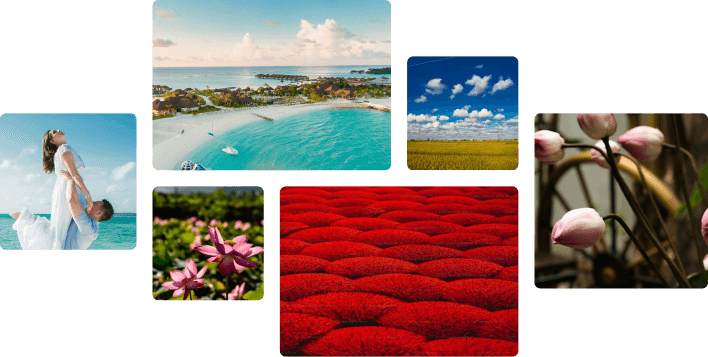
Vinh Phuc province is a popular tourist destination known for its beautiful scenery. The grandeur of nature, the wildness of the mountains and forests combined with the cool climate will definitely make you excited. So, what should you explore when coming to Vinh Phuc? What play? Where? Let's explore with 63S Travel the list of 22+ tourist attractions in Vinh Phuc right in the article below.
Top 22+ famous tourist attractions in Vinh Phuc near and far
With its majestic mountain and river system and historical relics, Vinh Phuc is becoming a new check-in destination for young people. Below are the top famous tourist attractions in Vinh Phuc for you to explore.
Tam Dao National Park
Located at an altitude of more than 1000m above sea level, Tam Dao National Park is the most famous town of Vinh Phuc. With a cool climate all year round, rich flora in spring, and foggy summer, Tam Dao offers a unique travel experience.
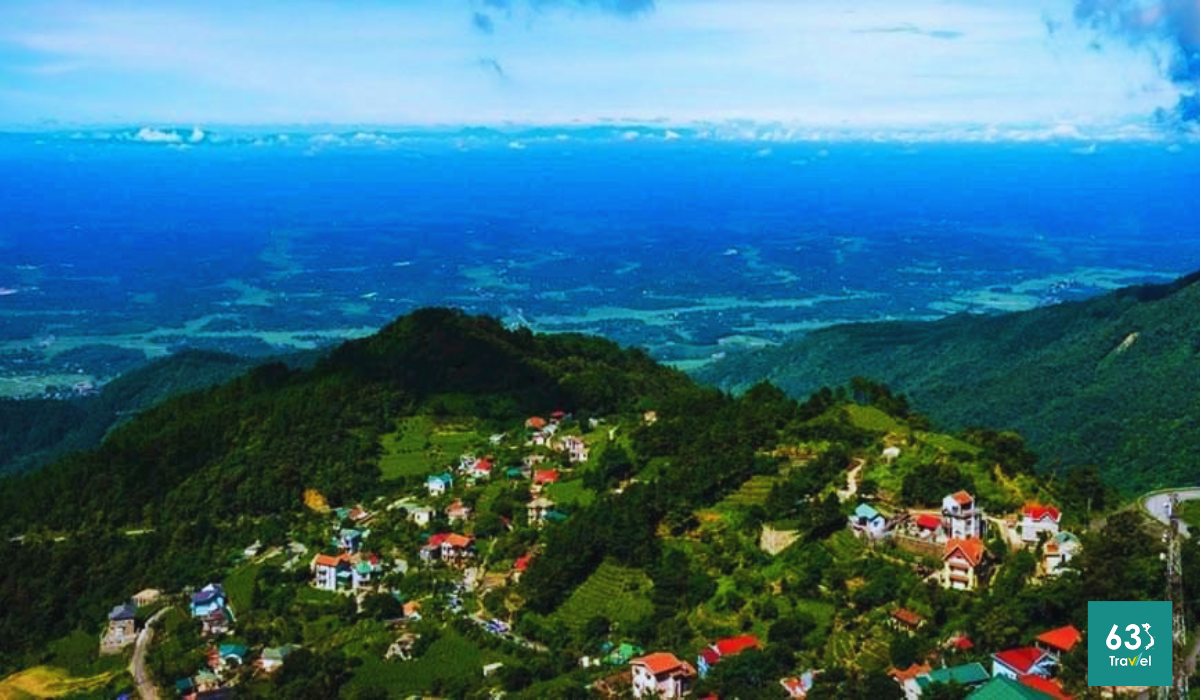
Tam Dao National Park - Explore the wild and mysterious beauty
Visitors can conquer beautiful spaces such as Tam Dao Square, Stone Church, Silver Waterfall... and enjoy culinary specialties. Enjoying the panoramic view and virtual life at the cafes is also an unforgettable experience for tourists visiting this place.
With the charm of the mountains, Tam Dao is becoming an ideal vacation destination in a majestic place. The best time to visit is in March and April, when rainfall is at its lowest.
Tam Dao Cloud Bridge
Located amidst the majestic nature of Tam Dao Mountain, there is a bamboo bridge spanning the cloud stream, a place to admire the drifting clouds. Tourists feel like they are lost in the blue sky, viewing the lush mountainous area of Tam Dao from above.
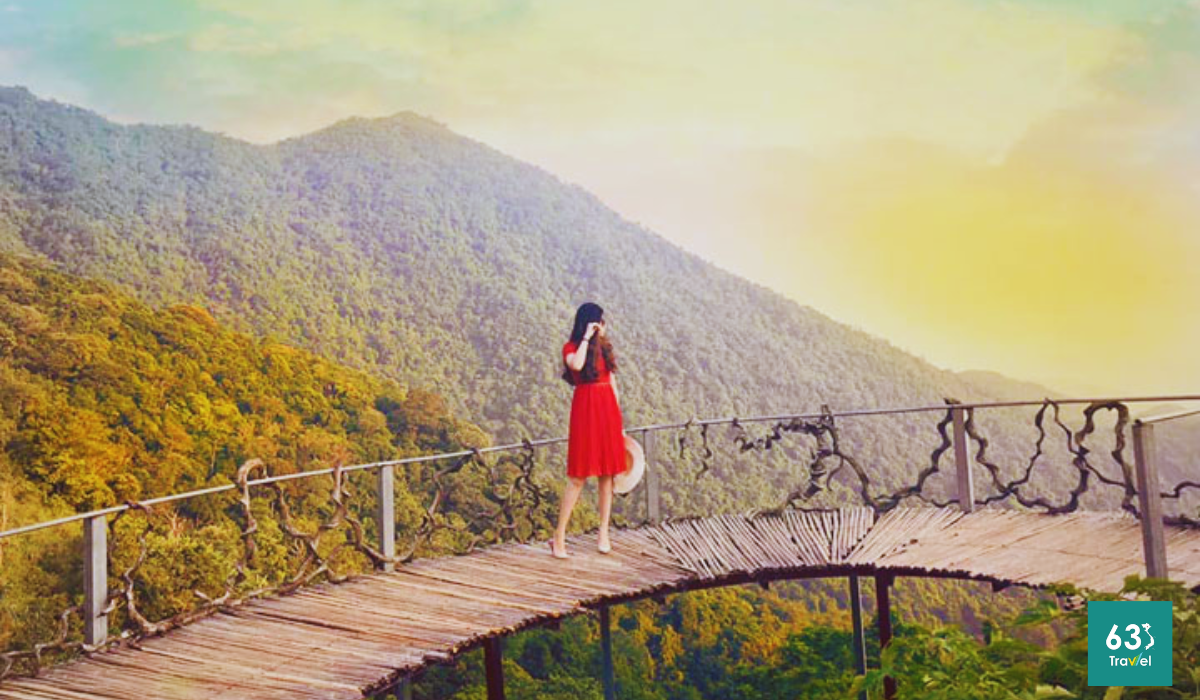
Tam Dao Cloud Bridge, a virtual living paradise, is sought after by young people
Early morning and sunset are the golden times for bloggers to "live virtual" with the most beautiful photos here. Tam Dao Sepak Takraw Bridge has also become a romantic "outdoor studio" for many couples to stop to record memories.
Xa Huong Lake
Located amidst the pristine natural scenery and majestic mountains and forests of Tam Dao, Xa Huong Dam has rare natural beauty. The artificial lake below the dam has an area of 83 hectares, the water is as clear as a mirror, reflecting the mountains and forests.
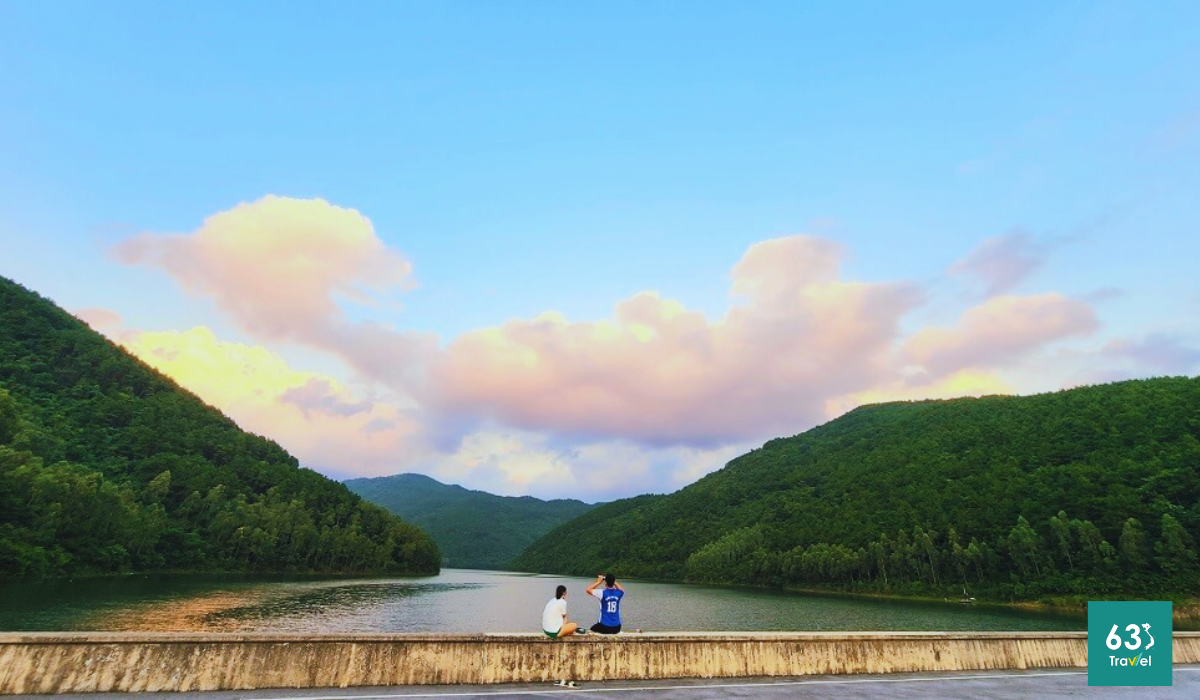
Explore Xa Huong Lake - the "muse" sleeping in the middle of Tam Dao mountains and forests
Fresh air and chirping birds create a wonderful chorus of nature. This is an ideal destination for those who love nature, want to bathe in streams, participate in teambuilding activities or go camping.
Dam Vac
Located amidst lush green vegetation, Dam Vac is a famous and exciting land of Vinh Phuc. The impressive beauty of this place is created by a diverse ecosystem. Especially the birds and pelicans fluttering their wings.
Dam Vac has become a land that fascinates tourists with its peaceful beauty of nature. Exploring Vac lagoon, visitors have the opportunity to fish or relax with fresh local seafood cuisine.
Ha Tien Pagoda
More than 300 years old, Ha Tien Pagoda has become a spiritual symbol of the people of Vinh Phuc. Not only do they pray for peace in the country and people, people who come to the temple also find peace in their souls.
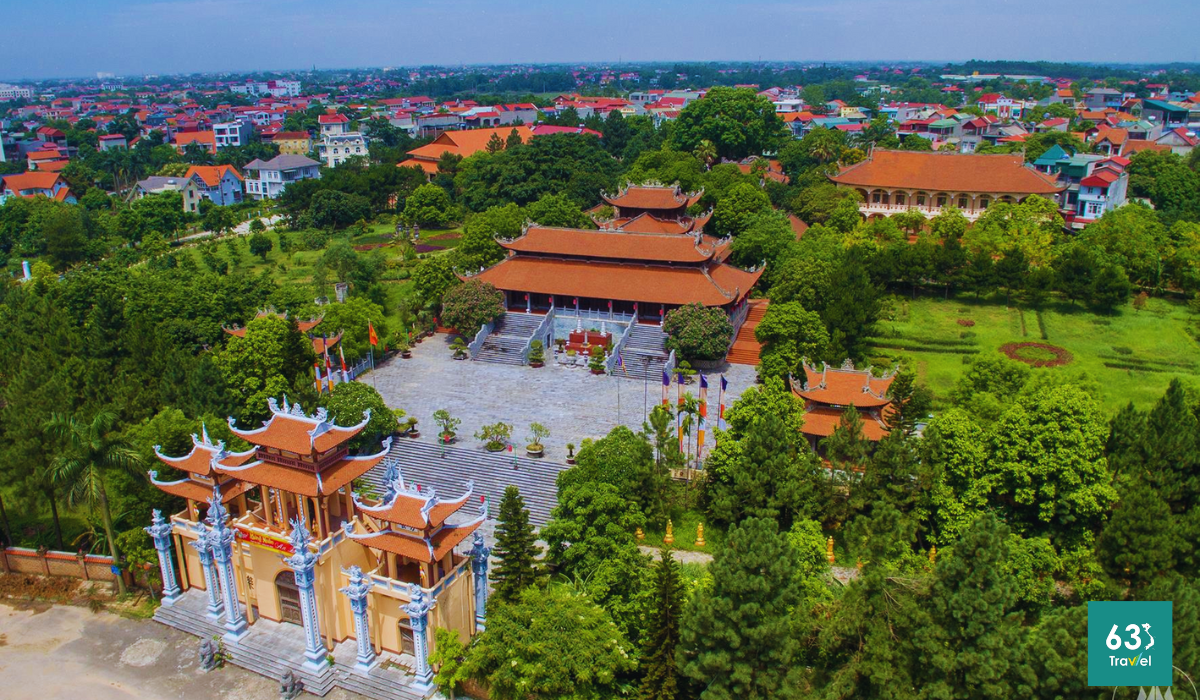
Ha Tien Pagoda - Famous fate-praying pagoda in Vinh Phuc
In the temple, there is a Jade Well with cool water, a miracle that is always passed down among the community. Every time they come to the temple, everyone asks for some well water to take home to burn incense for good luck.
Huong Canh Pottery Village
With a history of more than 300 years of establishment and development, Huong Canh pottery village (Vinh Phuc) has become an attractive tourist destination. This place is famous for quality handmade ceramic products with diverse designs. What makes Huong Canh ceramic different is not only the ceramic quality but also the color and sound. Due to the structure of the green soil, when fired, the ceramic makes a "clinking" sound like touching metal.
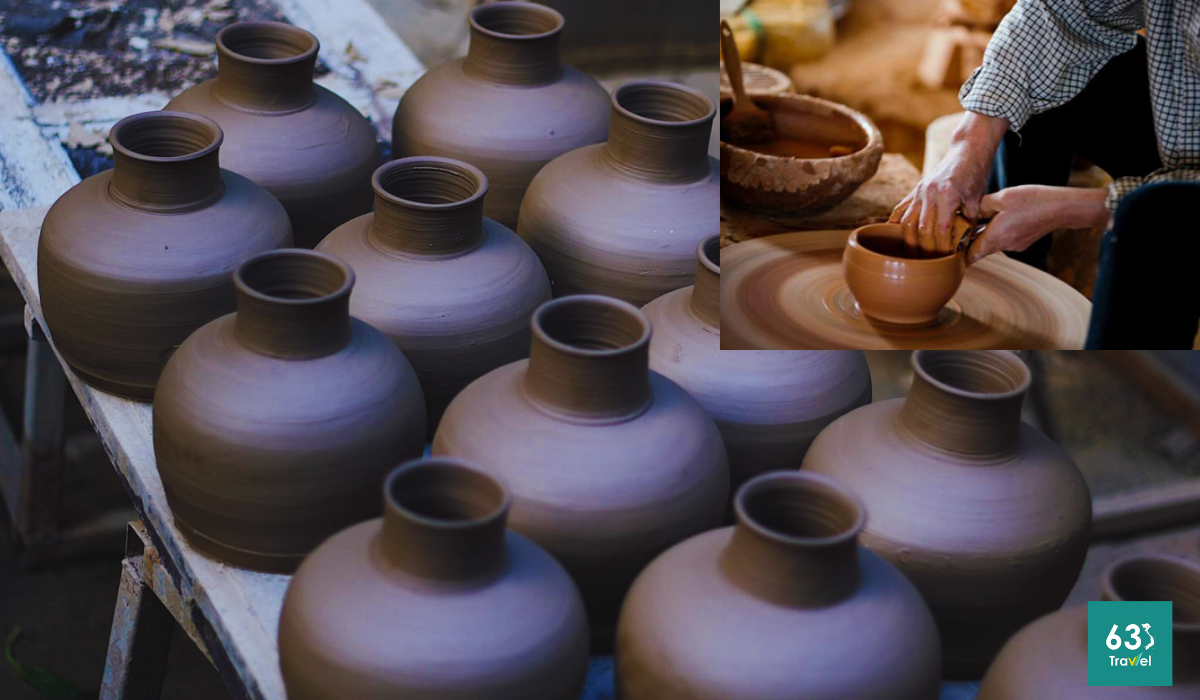
Huong Canh Pottery Village - Rustic Vinh Phuc ceramics
In particular, using Huong Canh ceramic when making tea will retain the fragrance and heat for a long time. If used to store wine, it will make the wine more delicious. Despite many difficulties, the village artisans still use all their enthusiasm to develop and preserve the traditional craft. Exploring Huong Canh Pottery Village, visitors have the opportunity to learn about the cultural and artistic identity of their homeland.
Me Linh flower village
Included in Vinh Phuc tours, Me Linh flower village is an attractive destination for tourists. With countless colorful flowers all year round such as roses, orchids, chrysanthemums... the flower village makes people fascinated.
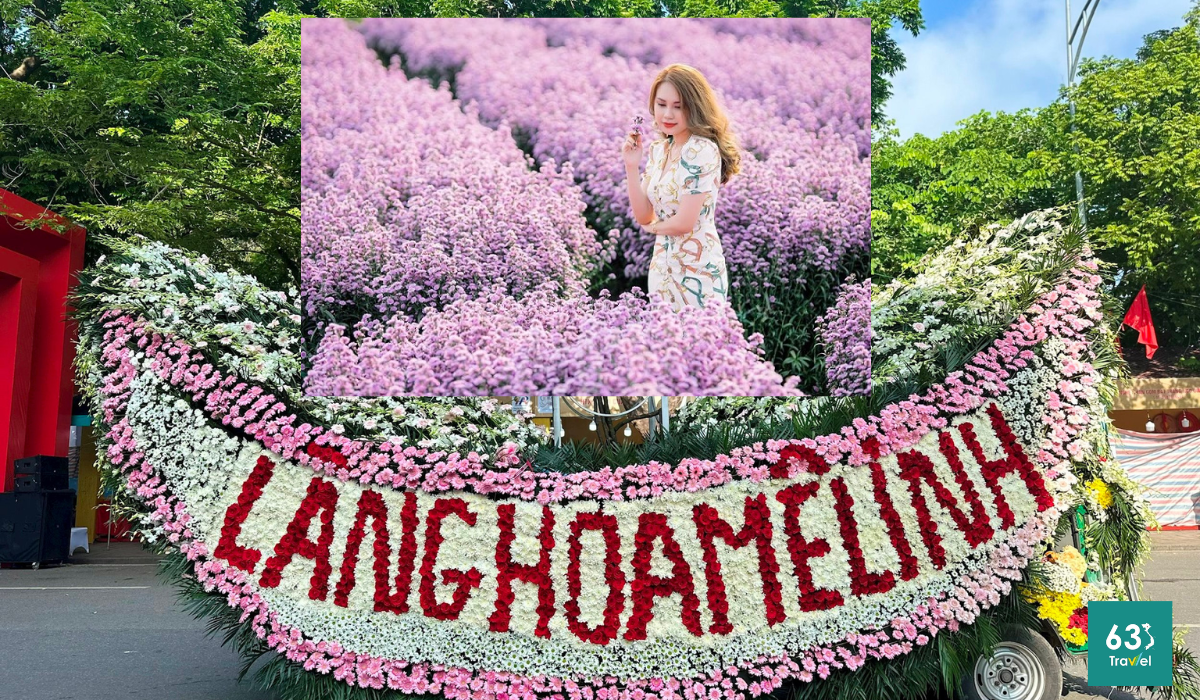
Admire the wonderful beauty of Me Linh Vinh Phuc flower village
Not only providing fresh flowers to Hanoi, Me Linh flower village is becoming a leading flower brand. Coming to the vast rows of flowers, visitors seem to be lost in a colorful flower paradise.
Bright Mountain
Hidden among the ancient green forests, Sang Mountain has a quiet, outstanding beauty. Gifted by nature, this place is like a precious gem of Vinh Phuc land with majestic landscape.
The cool, ancient stream gurgled and hundreds of years old trees spread their shade every day. Exploring Sang Mountain, visitors feel like they are lost in a natural fairy tale with memorable memories. This is a Vinh Phuc tourist destination suitable for exploration and picnic activities. Sang Mountain attracts a large number of people to come and experience nature.
Ban Long Lake
Located in the majestic Tam Dao complex, Ban Long Lake is hidden among rolling mountains. The lake surface is 20 hectares wide, the water is blue and dreamy, and the natural scenery is beautiful. Ban Long Lake is the top choice for picnics and camping activities with teammates.
This is an artificial freshwater lake, built for the purpose of serving irrigation, domestic water supply and tourism. Exploring the lake, visitors immerse themselves in the sounds of birds singing and the cool water, enjoying a relaxing vacation.
Binh Son Tower
Binh Son Tower (Tam Son, Vinh Phuc) is an architectural masterpiece built during the Tran Dynasty and preserved to this day. The unique feature of Binh Son tower that impresses visitors is that it was built without the need for lime or mortar. This is definitely the ideal place for you to check in during your upcoming trip to Vinh Phuc.
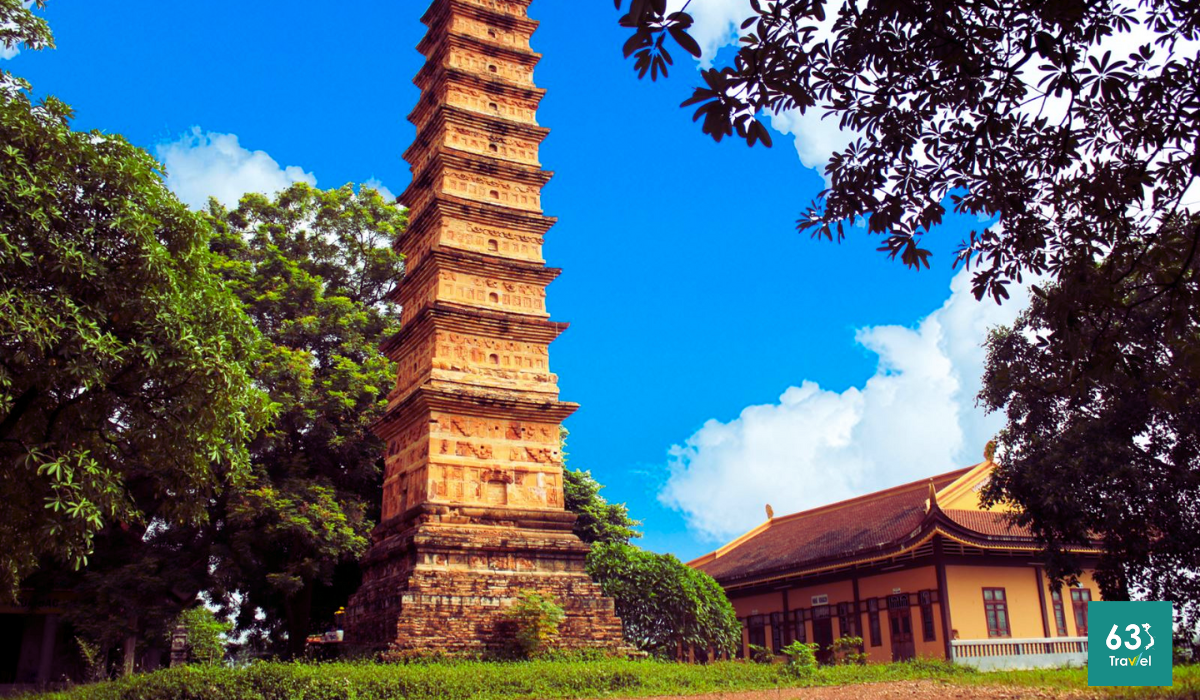
Binh Son Stupa Vinh Phuc - A special work that lives forever
Binh Son Tower's literal name is Vinh Khanh Pagoda Tower, also known as Then Pagoda. The tower has 15 floors but currently there are only 11 floors built during the Ly Tran period. With its unique architecture, Binh Son Tower becomes a cultural landmark, carrying the meaning of traditional education and patriotism and pride of the nation.
Duong Lam ancient village
Duong Lam ancient village still preserves the ancient beauty of a northern village with the image of a thousand-year-old banyan tree, a busy wharf, a peaceful temple yard... With those unique historical and cultural values, in 2006 The village is recognized by the State as a monument.
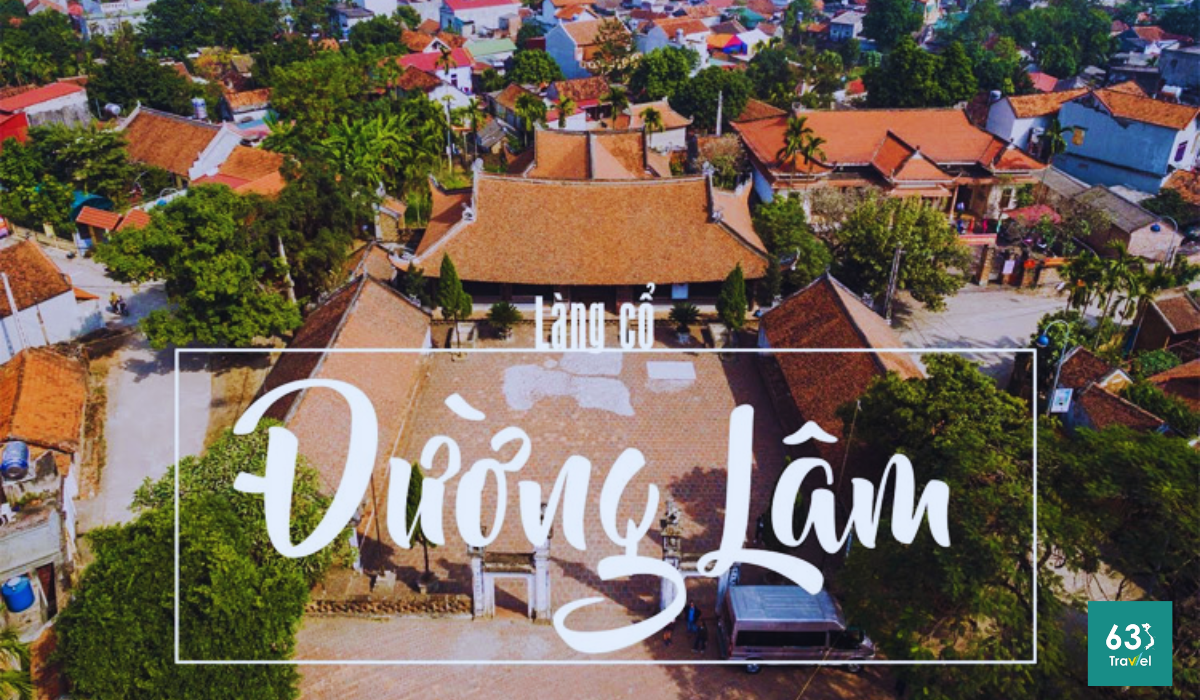
Admire the painting-like serenity of Duong Lam ancient village
This has become a destination attracting more and more tourists, thanks to the intact preservation of the homeland's cultural features. Exploring Duong Lam ancient village, visitors have the opportunity to learn about long-standing traditions and local culture from a young age.
Tich Son Pagoda
Located on the beautiful Tich Son mountain, Tich Son Pagoda possesses charming mountain landscapes and four-season green forests. As a national historical site, hundreds of years old, the pagoda preserves its ancient architectural appearance.
Tich Son Pagoda, also known as Ngu Phuc Tu, is the pagoda of 5 ancient Tich Son villages including Khau village, Dau village, Ha village, Tiec village, Sau village. The pagoda is blessed by mother nature with a fresh climate and beautiful landscape. Therefore, the pagoda welcomes a large number of Buddhists and tourists every year.
Possessing ancient architecture and many works including the Main Hall, the Patriarch's house, the three gates, the bell tower... In particular, the Main Hall was built in the shape of the letter Dinh, exquisitely carved, using wooden columns as pillars. In addition, the pagoda also preserves many artifacts and statues of historical value such as the 1m high statue of Amitabha Buddha sitting on a lotus throne.
Hai Luu stork garden
Located on the romantic Lo River, Hai Luu Stork Garden stretches 15 hectares, of which 7 hectares is where birds and storks nest. Exploring nature, visitors admire bird life and enjoy picnics and sightseeing.
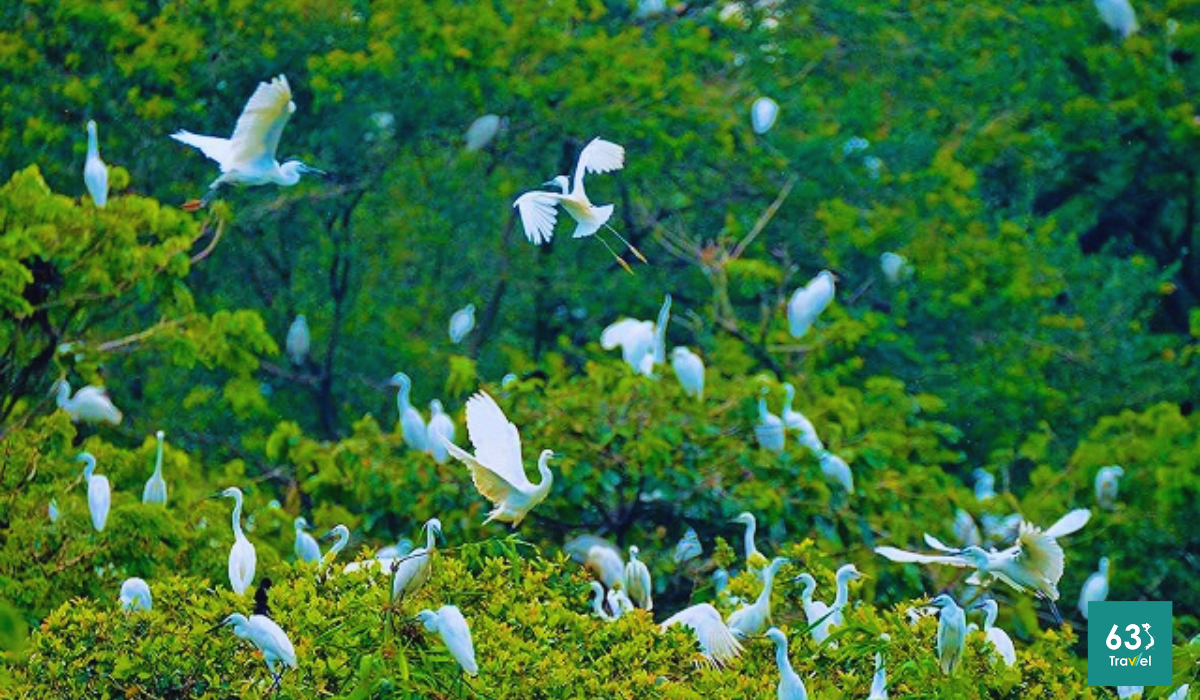
Hai Luu Stork Garden - a unique eco-tourism area in Vinh Phuc
The stork garden creates a unique identity for Song Lo with a green - clean - beautiful environment, attracting tourists to experience. This place has become an ideal vacation destination, increasing the value of eco-tourism for the homeland.
Vinh Son snake village
Located 20km from the center of Vinh Yen, Vinh Son Snake Village is a traditional craft village specializing in raising and processing snakes. Exploring the village, visitors see snakes being raised in solid cages and properly cared for.
At the snake village, visitors can learn how to raise and classify snakes. In particular, visitors can also enjoy special dishes made from snakes.
Truc Lam Tay Thien
As one of the three largest Zen monasteries in Vietnam, Truc Lam Tay Thien is located amidst vast green pine forests and vast fields. Vinh Phuc tourist destination attracts many tourists to pray for peace and luck for their families.
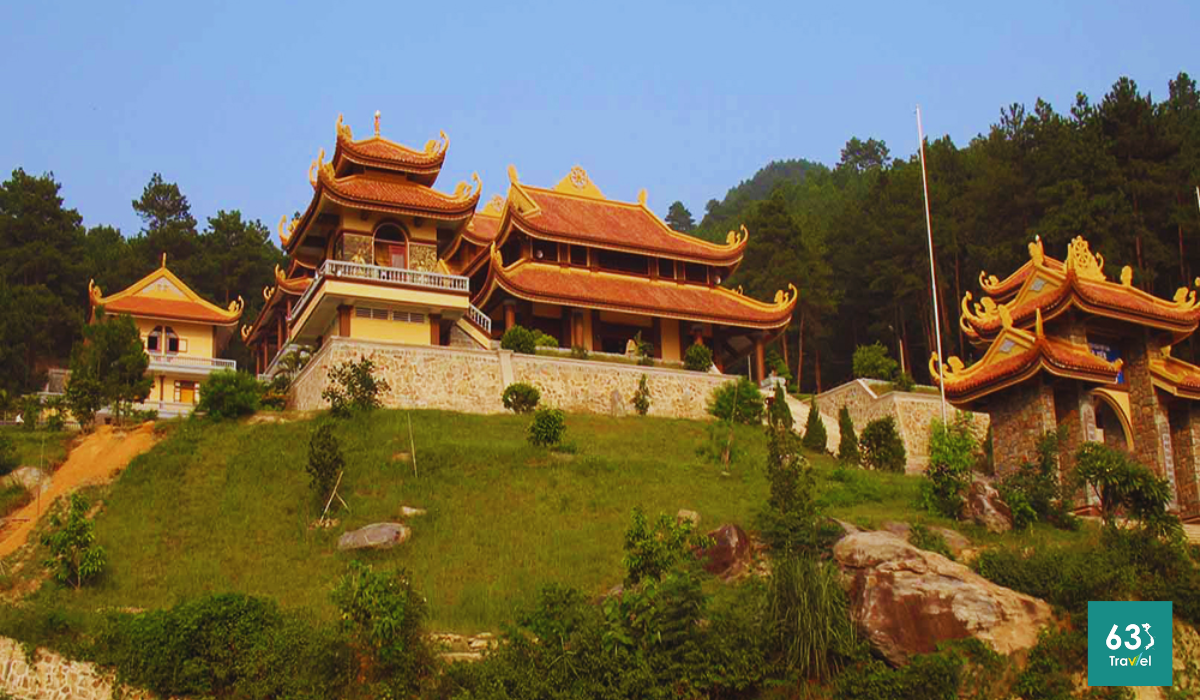
Truc Lam Tay Thien Zen Monastery - Buddhist landscape in Tam Dao
If you are healthy, you can conquer the 4km road to the Zen Monastery by foot to fully enjoy the experience. Or choose to go on the cable car to see the majestic natural panorama from above.
Ba Ao Waterfall
Also known as Tien Ba waterfall, it flows from Mo Qua mountain in the Tam Dao range. Located 70km from Hanoi, Ba Ao Waterfall is an ideal check-in point on weekend trips. This is where three elements of waterfall, lake and lush forest converge.
Three Ao falls at a height of 50m, hidden in the wild landscape of the majestic Tam Dao mountain range. The cool, fresh air from the stream flowing down brings absolute relaxation to visitors.
The special feature of Ba Ao is the combination of endless waterfalls, surrounding green forests and a stretching lake. Along with that is a soft, cool lawn right at the foot of the mountain, where visitors can comfortably rest and admire nature.
Tam Dao stone church
Located in the center of Tam Dao, the Stone Church attracts tourists thanks to its ancient Gothic architecture. Outstanding with a sky-high Bell Tower, gently patterned columns combined with arches to create a beautiful shape. If you are a lover of ancient beauty, you cannot miss this attractive tourist destination in Vinh Phuc.
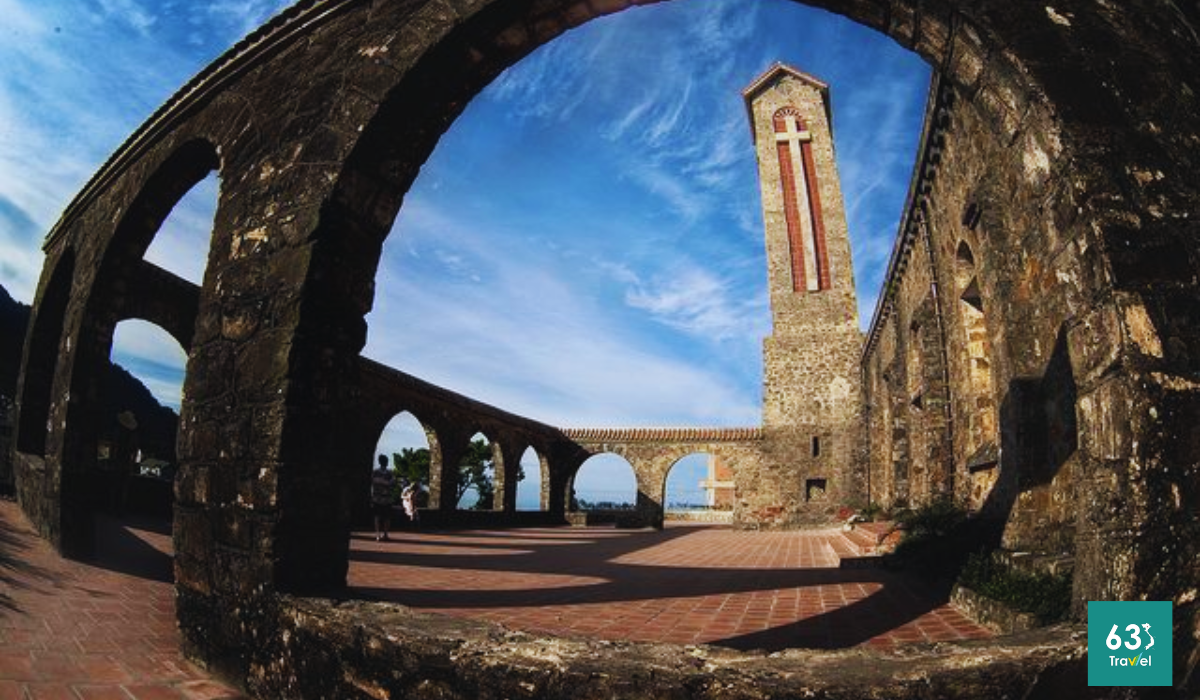
Tam Dao Stone Church - One of four famous stone churches in Vietnam
As one of four famous stone churches in our country, Tam Dao stone church was built in 1906 in a design style that still retains its cultural features. The interior is simple but full of meaning, and has become a familiar pilgrimage site.
Hill 79
25km from Hanoi, Hill 79 is an ecological area with a wild structure but has many interesting things for you to experience. Stepping inside, visitors will be conquered by the vast green forest, below is a clear lake. Up high is the Uncle Ho memorial close to eucalyptus trees, the climate is cool.
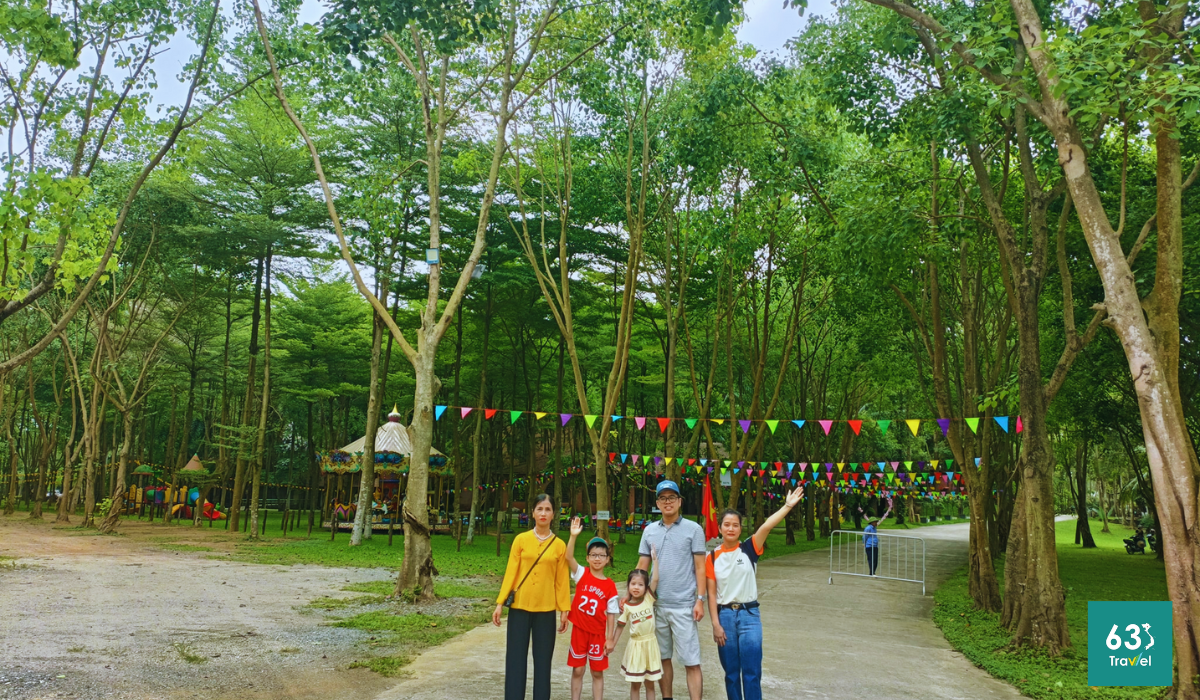
Ecological and spiritual tour at Hill 79 Spring
The space is decorated in a variety of ways, attracting all ages to take souvenir photos. If you have the opportunity to visit Vinh Phuc, you should take the time to check in to this hill 79 tourist destination.
Ho Chi Minh Square
As an important traffic hub, connecting historical and cultural relics in Vinh Yen, Ho Chi Minh Square creates a green space in the heart of the vibrant city. The square has become an ideal relaxation destination for people after stressful working hours.
Many rich cultural and artistic activities take place here, from photo exhibitions, street art to important festivals of the year. In particular, every weekend, the square becomes a meeting place for young people and families to carry out many fun and entertainment activities such as singing, dancing, sports... contributing to creating an atmosphere vibrant and fun for the city.
Dam Rung
Located right in the center of Phuc Yen City, Vinh Phuc Province, Dam Rung is famous for its clear and large blue water surface all year round. In the middle of the lagoon emerges a natural island with green lawns and luxuriant trees.

Vinh Phuc Rung Lagoon - A poetic place for the dreamy girl
In the summer, Rung lagoon becomes an ideal rendezvous for tourists. Cool air covers the area, gentle breezes blow to cool the body, visitors can enjoy the feeling of relaxation surrounded by fresh nature.
In addition, this is also an ideal place for outdoor sports activities such as boating, fishing... making exploring new lands more interesting and meaningful. With its unique natural beauty, Dam Rung has become an attractive destination for nature-loving tourists.
Ho Thanh Lanh
Located at the foot of the majestic Tam Dao range, Thanh Lanh Lake is famous for its clear blue water and charming mountain and forest views. This place used to be the place where Nguyen Danh Phuong District built an anti-Trinh - Le post for nearly 10 years, leaving a historical mark.
Nowadays, tourists come here not only to admire the landscape of the lake and forest with floating clouds and vast blue water, but also to visit relics such as: Doan Quan Quan, Elephant Bathing Area, Thi Chao Bang Beach... places to save money. keep memories of a glorious time of the nation.
Besides, Thanh Lanh is also an ideal entertainment destination for tourists with many sports and entertainment activities. The calm, fresh space brings absolute relaxation. Beauty combined with unique historical value makes Thanh Lanh a famous tourist destination in Vinh Phuc.
Ho Dai Lai
Located in the middle of the majestic Tam Dao hill steppe, Dai Lai Lake is a beautiful gift that nature has given to the people of Vinh Phuc and tourists. With an area of more than 2,000 hectares, the lake is surrounded by green mountains and hills all year round.
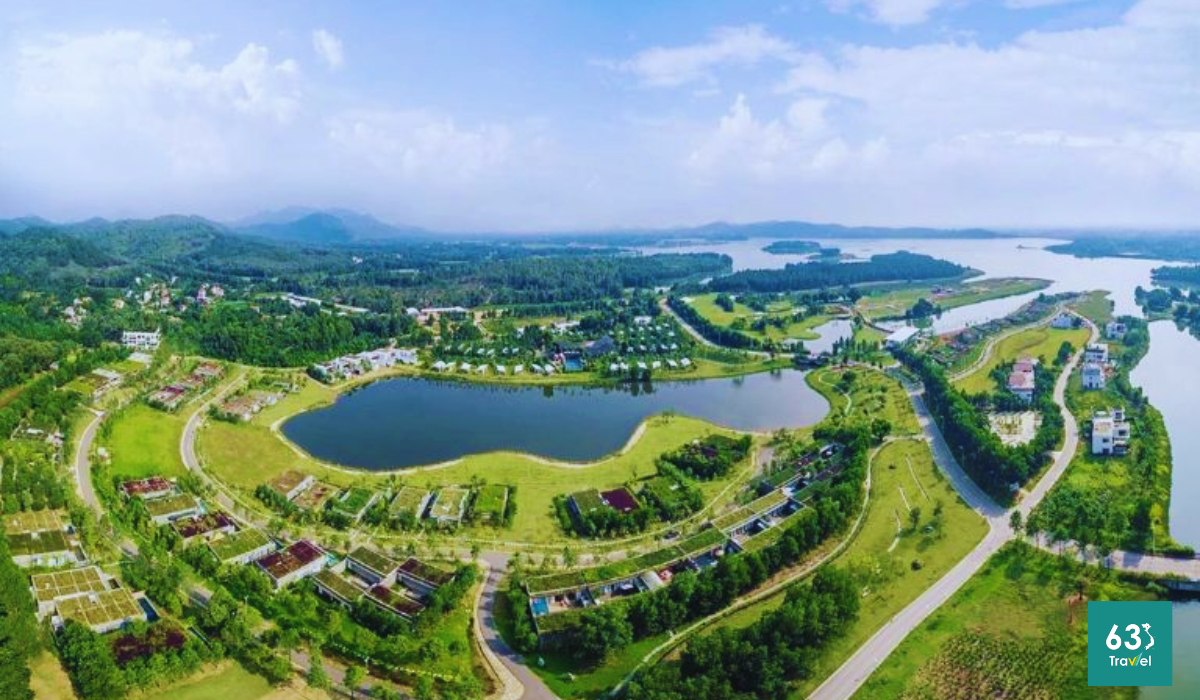
The pure beauty of Dai Lai Lake fascinates every tourist
The cool climate and gentle breezes always make Dai Lai Lake more poetic than ever. This place is an ideal meeting place for fun and sports activities such as duck riding, fishing, checking in to bird island... as well as visiting the impressive Flamingo Dai Lai tourist area.
On weekends, visitors can also enjoy special music performances at "Soul of Forest Music Night". With amazing natural space and professional tourism services, Dai Lai Lake is an interesting destination for all tourists visiting Vinh Phuc.
With impressive natural scenery, many unique architectural works, traditional craft villages, ideal vacation spots... Vinh Phuc is a great destination for you to freely explore and check in. Hopefully, the suggested list of 22+ tourist attractions in Vinh Phuc mentioned above has helped you plan your trip more conveniently. Wishing you a very enjoyable trip!
Phu Tho 6051 view
Update day : 06/05/2024
Hung Temple is a place of worship for 18 generations of Hung Kings and the king's royal family, those who contributed to building the country and are considered the Ancestors of the Vietnamese people. In the past, this land was the capital of Van Lang country, surrounded by two rivers and rolling mountains. That terrain has caused this place to have many rivers, lakes, mountains, hills and fertile alluvium, creating favorable conditions for people to settle down, and at the same time it is easy to defend or retreat in case of disaster. case of conflict. According to scientific documents, the Hung Temple complex began to be built on Hung Mountain during the reign of King Dinh Tien Hoang (968 - 979). Then, around the 15th century, under the Later Le dynasty, the entire relic site was completely built to the current scale. Hung Temple has a total area of 845 hectares with 4 temples, 1 pagoda, 1 mausoleum and many other architectural items, distributed from the foot of the mountain to the top of the mountain, in harmony with the overall majestic landscape. Over time, many relics in the Hung Temple complex have been embellished and supplemented but still retain their ancient and solemn features. For thousands of years, Hung Phu Tho Temple has been a solemn, respectful symbol, closely associated with the cultural and religious life of the nation. Hung King's death anniversary is held on the 10th day of the third lunar month every year and has entered the subconscious of every Vietnamese person with the folk song "No matter who goes back and forth - Remember the death anniversary on the tenth day of the third month". Every year on this day, millions of Vietnamese people from all generations of "Dragons and Fairies" eagerly return to their ancestral land to offer incense at Hung Temple to express their gratitude to their Ancestors and remember their roots. nation and pray for peace, health and good things. With special historical, cultural and scientific value, Hung Temple is ranked as a special national relic according to Decision No. 1272/QD-TTg, dated August 12, 2009 of the Prime Minister. It can be said that Hung Temple is a convergence of profound spiritual cultural values of the Vietnamese ethnic community throughout history. This is expressed very specifically and vividly through the worship of Hung Kings and the Hung Temple festival. Hung Temple Festival is a major festival in Vietnam of national stature, attracting the attention of all Vietnamese people with the blood of "Dragon and Fairy", whether living in the country or abroad. . Since 2012, the worship of Hung Kings has officially been recognized by UNESCO as an Intangible Cultural Heritage of Humanity thanks to its unique and distinct values. This is an important milestone and a great honor not only for the people of our country but also for the entire nation.
Phu Tho 5594 view
February to April
Since ancient times, Mother Goddess worship has become a typical beauty in Vietnamese culture. Many historians believe that this custom comes from the land of Hien Luong (Ha Hoa district, Phu Tho province), where the Au Co Ancestor Temple is located. Under the lush foliage of the ancient banyan tree, countless generations of Lac Hong's descendants have offered incense to pay their respects to Mother Au Co and told each other the legend of the nation's great mother. Legend has it that, the day Au Co was born in Lang Xuong cave (now in Thanh Thuy district, Phu Tho province), there was auspicious clouds protecting her, and a fragrant fragrance spread throughout the space. Growing up, she was beautiful, smarter than most people, read carefully, was good at playing the flute, and was proficient in phonics. After marrying Lac Long Quan - son of Kinh Duong Vuong, Au Co gave birth to a sac of eggs, which hatched into one hundred children. One day, seeing that his children had grown up, Lac Long Quan said to Au Co's mother: "I am a Dragon, you are a Fairy. Although yin and yang come together to form a hundred children, it is difficult to unite because of the different lineages." copper". Having finished speaking, Lac Long Quan led 50 children into the sea. Au Co's mother took her 50 children to the mountains, wherever they went, they conquered people's hearts and cleared the wild forests. One day, passing through Hien Luong, where there were high mountains, wide fields, and long rivers, Mother immediately cleared the land and taught people to cultivate rice, grow mulberries, raise silkworms, and weave cloth. When the farm was beautiful, Mother hurried to a new land. Later, Au Co's mother returned to Hien Luong, remaining attached to this place for the rest of her life. On the 25th day of the twelfth month of the year Nham Than, Au Co's mother flew to heaven, leaving a silk bib under the banyan tree. There, the people built a temple to worship and forever commemorate the National Mother. Au Co Ancestor Temple was officially built during the reign of King Le Thanh Tong (1442 - 1497). The legend of the temple records that the temple is hidden under an ancient banyan tree, facing south, on the left is Loan well, on the right is Phuong well, in front is Giac mountain as beautiful as a script, behind is Giac mountain. The Red River meanders like a sacred dragon surrounding it. Over more than five centuries, the Mother Temple has seriously degraded. In 1998, the Party Committee and people of Hien Luong restored the temple. The temple is not large or massive, but it is highly appreciated for its art. Visitors can find here many relics such as the statue of Au Co, the statue of Monsignor Cao Son, or delicate carvings on the hammock doors, crossbeams, and friezes around the upper palace door. Currently, the main temple has a Dinh-style layout with three harem rooms and five grand worship rooms. Mau Au Co Temple combined with Linh Phuc Pagoda creates a relic complex that has a special attraction for tourists from all over. Ms. Nguyen Thi Tuyet Mai, Head of the Management Board of Au Co Mau Mau Temple Relic Area, said: "With the consent of the government, we are quickly restoring the temple to worship Monsignor Dot Cao Son (the second son of Mau Temple) is located 500m east of Mau Temple to meet the sightseeing and religious needs of the people.
Phu Tho 3638 view
February to May
8km from Au Co Mau Temple, Ao Gioi - Suoi Tien tourist destination is located on Na mountain in Quan Khe commune, Ha Hoa district. This is a tourist destination with wild beauty, fresh and cool air, suitable for tourists who love to explore. According to legend, on the morning of January 7, Mother Au Co went west to No mountain, later called Na mountain, and encountered a rock crevice. She went up the cliff and met a group of fairies who brought down dresses for her. Replace and welcome Mother to heaven according to the Jade Emperor's orders. The water where Mother bathed flowed down to the foot of the mountain, forming a stream, later generations called it Ao Gioi - Suoi Tien and anyone who bathed in Ao Gioi - Suoi Tien for 3 years would have smooth white skin like pearls and a bright face. beautiful like the full moon. The road to Ao Gioi - Suoi Tien has many large and small mountain peaks on both sides, in which Mount Na towers higher than the surrounding mountains. Visitors can take two main routes to visit Ao Gioi, Gieng But, Vuc Xanh, Tien Cave, Bottomless Cave, Ban Che Waterfall, and Canh Tien. Fairy Stream originates from Na mountain, flows through rock crevices like a silver-white silk strip, across the mountainside, standing out among the smooth green of the mountains and forests mixed with the blue of the clouds and sky, creating a poetic scene. just close. Water flows from Na mountain through many waterfalls into a clear stream. The stream bed is thick with gravel and yellow sand, making the stream water pure, clear, and sparkling with reflected sunlight. At the source of the stream is Fairy Well. From the bottom of the well, cool and sweet water sprays out to form Fairy Stream. Fairy Stream winds through many levels and steps, creating many vertical waterfalls. Along the length of the stream, there are many waterfalls, some 20m high, white foam day and night, including Ban Co and Canh Tien waterfalls are the most beautiful waterfalls. Both sides of the stream are covered with a dense green color of tropical plants, crowded together in layers and layers. The wild scenery and fresh air create a rich flora and fauna system in Ao Gioi and Suoi Tien. At the foot of the high waterfalls are giant stone slabs that, over a long period of time, have eroded into small ponds whose bottom is a whole slab of stone, creating a unique beauty here. Ao Gioi - Suoi Tien is still pristine, has abundant tourism potential, can develop all types of climbing, camping, relaxation and scientific research because the flora here is very diverse and rich. rich. Currently, the road to this tourist destination has been paved, making it convenient for visitors to have interesting experiences here.
Phu Tho 3818 view
March to November
According to experience traveling to Xuan Son National Park, traveling here at any time is reasonable because each season has different beauty. In the dry season, the road is easier to travel, can limit more risks, the scenery is fresher and more convenient for going out. But in the rainy season, although the road to Xuan Son National Park may be a bit difficult, visitors will admire the rare, majestic and powerful murmuring waterfall. Depending on each person's needs, the amount of items they carry may vary. Because there are not many grocery stores or places providing consumer services near this tourist destination, visitors must proactively bring clothes, personal items, food (candy, instant noodles, milk...), shoes..etc... If you are more careful, bring a spare battery charger for your phone or camera. When coming to Xuan Son National Park, first, we must mention: Hang Na, Hang Lang, Hang Lun, Thien Nga Cave, Tho Than Cave with many wild, cool and beautiful scenes, close to humans but not Less magical and mysterious. Next, visit the villages in Xuan Son National Park to learn about the culture, primitive and simple life, and unique customs of the people here. Join them to experience daily tasks such as knitting utensils, weaving brocade or fermenting wine, fishing in streams near the village, etc., ensuring that these activities will be no less attractive. interesting. After that, take a walk around the market. Many ethnic items are sold in the market so you can freely choose meaningful items as gifts for friends, relatives or to use for your own needs. me. If you go home during the day, you can proactively eat and drink and bring your own fast food. Otherwise, you have to move to Tan Son town or Viet Tri city to enjoy delicious dishes in Phu Tho. Some suggested dishes are: Phu Tho sour meat, Phu Tho dog meat, cassava vegetable soup stewed with pig's feet...etc. Prices at eateries and restaurants in Phu Tho are very affordable, with absolutely no cutting corners for profit.
Phu Tho 3476 view
March to August
Long Coc tea hill or Long Coc tea oasis is a tourist destination located in Long Coc commune, Tan Son district, Phu Tho province. About 125 km from Hanoi, Long Coc is a collection of hundreds of bowl-shaped hills located one after another. The tea hill area is up to 677 hectares, the tea area that can be harvested is 610 hectares. As a new tourist attraction of Phu Tho province, this place attracts tourists with its poetic and picturesque scenery. Not only can they admire the long, winding green tea hills, visitors to Long Coc also have the opportunity to learn about high-quality tea varieties such as LDP1, LDP2, PH1, PH8... In addition, this is also an opportunity to Great for you to enjoy Shan Tuyet tea and specialty Bat Tien tea. With heavenly landscapes and mild climate, Long Coc is a destination that you can visit at any time of the year. The most ideal time to travel to Long Coc tea hill is from March to December every year. At this time, green tea leaves cover the entire hill, forming vibrant green carpets. From December onwards is the "hibernation" time of tea, tea hills become diverse in lines and shapes, stimulating the imagination of viewers. If you want to take beautiful photos, you should come here early in the morning, which is best in early summer. At that time, the entire space will be immersed in a mist, with a little light light at the beginning of the day. In that atmosphere, everything around was suddenly strangely beautiful and peaceful. Dubbed the "Ha Long Bay of the midlands", Long Coc is one of the most beautiful tea hills in Vietnam. Possessing countless potential for tourism development, this place has no shortage of interesting experiences waiting for you to explore. Long Coc tea hill has a total area of more than 600 hectares, characterized by a lush, picturesque landscape. The hills are undulating, running one after another to the horizon, like giant upside-down bowls. Dotted on that majestic picture of nature are images of workers picking tea, carrying bamboo baskets on their backs and wearing conical hats, so beautiful it's heartwarming. The most beautiful tea hills in Long Coc Phu Tho are Doi 3 and Doi 5 tea hills. These are the two tea hills located at the highest position in the hill system in Long Coc. From here, you can see far away and see the entire lush tea hill landscape. During each season change from autumn to winter, fog thickly covers the hill, creating a poetic and mysterious scene. At dawn, the clouds rush in and blend with the mist to cover the path, making an extremely impressive impression. The stretching green color of Long Coc tea oasis is a super beautiful check-in background for "virtual living" believers. Dawn is the most ideal time for you to take photos of the tea hills. At this time, the tea hills were still sleeping under the mist, the morning dew condensed on the leaves, creating a scene that was as dreamlike as reality, as beautiful as a fairyland. One of the most interesting experiences when coming to the green tea capital of Long Coc is enjoying the specialties here. Visiting this land, visitors must definitely try the following list of dishes: Thanh Son sour meat, Banh tai, Braised fish filling, Banana stir fry,... and many other delicious dishes.
Phu Tho 3734 view
From March to December
Favored by Mother Nature, Thanh Thuy Hot Mineral possesses underground water with temperatures ranging from 45 to 60 degrees Celsius all year round. In recent years, Thanh Thuy Hot Minerals is a Phu Tho tourist destination that has attracted the attention of many people, especially those who are concerned about health issues. As the first hot spring source in the Northern region rich in Radon content that can strengthen the immune system, it is not surprising that this is a tourist destination with a large number of people visiting each year. In particular, today, the resort's campus is also designed with more entertainment areas and amenities such as swimming pools and restaurants to give people more options. Thanh Thuy hot mineral water is the result of geological tectonics. The water temperature is always hot from 45 to 60 degrees Celsius all year round, even on rainy season days. The nutrients in water have the effect of beautifying, treating skin diseases, good for the heart as well as increasing immunity. Coming here, you can relax and soak in Thanh Thuy hot mineral water to circulate blood and relieve stress after busy days at work. Within the resort grounds, there are saunas, mud baths, jacuzzis and swimming pools for everyone to choose from. Besides bathing in Thanh Thuy hot spring, when you come here, you also have the opportunity to enjoy a series of specialties of the ancestral land of Phu Tho. The resort's restaurant is designed in the style of a stilt house, located right next to the lake so it is always cool and airy. The restaurant's menu is very diverse, mainly local specialties, such as Da River barb fish, lentil fish, carp, wild boar, hill chicken and mountain goat, etc. The dishes are seasoned with local flavors and made from fresh ingredients, promising to bring you memorable culinary moments. In order to bring memorable moments of relaxation to everyone, Thanh Thuy hot mineral tourist area also arranges tennis courts, karaoke rooms, fishing, bicycles and campfires. Surely your trip back to the ancestral land of Phu Tho will be more memorable and unique than ever.
Phu Tho 3830 view
From January to December
Bac Cung Temple (literally known as Thinh Temple) in Tam Hong commune, Yen Lac district is one of four large temples around the Ba Vi mountain region and the Red River Delta worshiping Saint Tan Vien. The temples: Tay Cung, Nam Cung, and Dong Cung are on the other side of the Red River in Son Tay territory. These are four temples that were built and preserved relatively carefully by the people. The temple is located in the middle of fertile fields on a 10,000 square meter plot of land next to winding canals, surrounded by rich and densely populated villages. On both sides, the left desert and the right desert stand majestically and silently, covering a large brick yard, looking up to a unique architectural work. Thinh Temple was built 20 centuries ago on the foundation of a small temple worshiping Saint Tan, where he had previously let his troops stay during a mission to help people clear land and manage water. The divine genealogy passes down that: Saint Tan (still called Son Tinh), whose name is Nguyen Tuan, was born on January 15, Dinh Hoi year in Lang Xuong cave, Trung Nghia commune, Thanh Thuy district, Phu Tho province. He lost his father at a young age and lived with his mother and two cousins, Nhuy Hien and Nguyen Sung. Every day, the three brothers crossed the Da River and went to the Ba Vi mountains to clear fields and farm, looking for a living. Here, Nguyen Tuan met Princess Thuong Ngan, was adopted by her, and gave her a walking stick and many magic spells to save humanity. After defeating Thuy Tinh and marrying Princess Ngoc Hoa, he refused the throne that King Hung wanted to give him, and with his two younger siblings traveled everywhere, helping people clear land and water, and was respected by people everywhere. When passing through the Tam Hong area, he let the troops rest and taught the people to grow rice and fish... After he left, the villagers came to the place where the Holy One rested and saw that there were still some packets of hearing left there, so after This temple is called Thinh temple. There is also a story that: when letting the army stay here, Saint Tan taught the people to butcher Thinh, so the people called the temple that name. From a small temple, during the reign of King Ly Than Tong (1072-1128), the temple was rebuilt into a large temple. This is where the king came to pray for longevity. During the reign of King Minh Mang (1820-1840), the temple was repaired many times. During the reign of King Thanh Thai, the Tri of Yen Lac district appointed monk Thanh At to restore the temple. The project lasted until the 6th reign of Khai Dinh (1900-1921). Through many ups and downs, the temple continues to be preserved and preserved by local people. On January 21, 1992, the temple was recognized by the Ministry of Culture and Information as a cultural and historical relic. Every year, the Thinh Temple festival is held from the 6th of the first lunar month to the 20th of the first lunar month. The festival includes sacrifices, palanquin processions from villages inside and outside the commune and many folk games will be held. Source: Vinh Phuc province electronic information portal
Phu Tho 5161 view
Bao An Pagoda, the full name in ancient documents is Bao An Thien Tu or Tu Gia Bao An, the popular name is Cam Pagoda, formerly belonging to Thap Mieu commune, Bach Tru canton, Yen Lang district, Phuc Yen province, Now belongs to Trung Nhi ward, Phuc Yen city, Vinh Phuc province. The pagoda was built in the 12th century during the reign of King Ly Cao Tong (1176-1210). This is one of the few pagodas dating back to the Ly Dynasty until today. The pagoda is built on a high hill, with luxuriant trees, windy on all four sides, beautiful scenery, quiet, full of solitude, a place of meditation. In the past, this area was called Tieu Dao Mountain, and is commonly called Cam Forest, perhaps that's why the pagoda is famous as Cam Pagoda. According to inscriptions and genealogies, the pagoda has existed for a long time. In the 12th century, the crown prince, son of King Ly Cao Tong, donated more than a hundred acres of fields, two thousand francs of money to repair the pagoda, and 700 francs of merit for a banquet. worship easily. Assign martial general Nguyen to directly direct and mobilize donations to repair the pagoda. As a result, the pagoda was restored with "seven newly built closely spaced rooms, columns painted with bright flowers, bright jade colors, a high and precious palace, bright sunlight and moonlight, a splendid Buddha statue, and a poised lotus throne." , the big bell towers over the phoenix, the noble king holds the dragon, the splendor and majesty are clear...". The military general of the Nguyen family also had the merit of a thousand francs to buy more than a hundred acres of fields to donate to the pagoda for farming. In the 14th century under the reign of King Tran Anh Tong, Bao An Pagoda was given a lot of money to repair and embellish by Princess Hung Nuong. To remember his merits, like many other pagodas in the area, people built a shrine to Princess Hung Nuong in the pagoda. Having gone through the ups and downs of thousands of years of history, Bao An Pagoda is still at the old campus but has had many changes. Ancient architectural buildings such as the front hall, incense burner, upper palace, ancestral house, Hung Nuong princess shrine and mother shrine were demolished due to deterioration. Currently, the pagoda has been renovated and rebuilt on a large scale, with reinforced concrete architecture and tiled roof. The pagoda also preserves valuable relics and antiques such as: Dharma statues, altars, bronze bells, and stone stele. Among them, the most typical is the stone stele "Bao An Zen Tu Bi Bi Ky" (inscription of Bao An Pagoda's stele). Up to now, according to review, survey and statistical data, this is the only Ly Dynasty stele remaining in the province. The stele was engraved in December of the year Tri Binh Long Ung (1209) and re-engraved later, probably at the end of the 18th century, placed at Bao An pagoda. The stele was mentioned and published by many researchers in Ly Tran Poetry (Social Sciences Publishing House, H.1977) and Ly Dynasty Epitaph (VNU Publishing House, H.2010). This is the oldest stele in Vinh Phuc and one of the 18 Ly Dynasty stelae remaining in our country today. The stele is 1.4m high, 0.85m wide, 0.14m thick, placed on the back of a smooth-shelled stone turtle, its head protruding, its four-clawed feet spread out in all four directions. The stele is engraved on both sides with 50 lines including 1498 Chinese - Nom characters, sharp handwriting in the style of Ly Dynasty script, very beautiful. The content of the memoir was composed by Wei Tu Hien in a parallel, parallel, and concise writing style. At the end of the memoir is an essay written in the style of Buddhist verse. The content of the stele describes the splendid and splendid scene of Bao An Pagoda in the 12th century, recording the merits of repairing the pagoda of Prince Sam, son of King Ly Cao Tong, military generals of the Nguyen family, along with Buddhists and people there. This. According to Nguyen Huu Mui (Research on Vinh Phuc Inscriptions, 2013), although the epitaph is still full of exaggeration, the image of a Ly Dynasty pagoda is clearly shown: the pagoda was restored by just one person. , the scale of the pagoda is large, inside the pagoda there are Buddha statues and lotus flowers, outside the pagoda there are bells and openings; The pagoda owns a lot of land and has a Thich Giao Zen Association (a type of Buddhist association, offering temple protection) to manage the meditation area. Based on this stele, it can be seen that the construction and restoration of pagodas took place on Vinh Phuc land since the Ly dynasty. The construction and restoration of pagodas was encouraged, not prohibited, by the royal court and assigned to the mandarins and aristocracy to preside and organize. The construction and restoration of pagodas is also considered an important event in the spiritual life of the people, attracting the whole region and even the whole country to join in the merit. This proves that during the peak development of Buddhism during the Ly Dynasty, Vinh Phuc area was also a popular center of this religion. The special thing is that among the nearly 1,500 words on the stele, there are mixed Nom words, these Nom words are used to write people's names and land names. It is said that this is one of the oldest evidences of Nom script found in Vietnam. Before this stele, traces of a few Nom characters were only found in two places: on the bell of Van Ban pagoda, Hai Phong (year 1076), and in an inscription at the pagoda of Huong Non commune, Tam Nong district, Phu Tho province. (year 1173). Bao An Pagoda was ranked as a provincial historical-cultural relic in 1995. In the period 2021 - 2025, Vinh Phuc province plans to build a scientific dossier to request recognition of the National Treasure for the pagoda steles. Bao An and upgrading the national monument ranking for Bao An Pagoda relics, these are activities to further strengthen the management, conservation and promotion of heritage values. Source: Bao An Pagoda Vinh Phuc
Phu Tho 4642 view
Binh Son Tower (Then Tower, Then Pagoda Tower, Vinh Khanh Pagoda Tower) is located in Tam Son town, Song Lo district, Vinh Phuc province; is a Buddhist architecture bearing the mark of a rather long period (approximately from the 14th to 16th centuries). Binh Son Tower - Vinh Khanh Pagoda is located on a high and spacious mound, the area of the protected area is 17,200m2, including: Binh Son Tower, old Tam Bao building, new Tam Bao, ink well, house Guesthouse, lotus pond, gate, auxiliary works. 1. Binh Son Tower The tower is currently 16.5 meters high, (only 11 floors and 1 pedestal remain because the top of the tower was broken), and is constructed with a square plan that gradually gets smaller towards the top, with the side of the bottom floor being 4. 45 meters, the side of the 11th floor is 1.55 meters. The entire tower is built of unglazed fired bricks. From the base of the tower to the end of the 2nd floor, it is less than 6 meters high with the most complete pattern. On these two floors, there are carefully decorated motifs with rows of chrysanthemums, lotus petals, leaves, smooth-faced flowers, embossed dragons, and the "whispering lion" motif... From the third floor up, the decoration is still the same. However, the higher you go, the narrower the width of the tower's face is, and the decorations also gradually decrease. 2. The old Tam Bao Palace: was majorly restored in 1976, in the shape of the letter Dinh, with an area of 131.5 m2, including 5 rooms for the front hall and 3 rooms for the harem. In particular, the building has 2 bronze pillars in front, stretching out 6m, forming like the arms of a throne. The system of worship statues here is mainly made of painted soil, dating from the late 19th and early 20th centuries, with a few statues dating to the 20th century. 3. New Three Jewels: built in 2012, on the foundation of the old Three Jewels house, the architectural form is Zen monastery style. 4. Ink Well: Legend has it that this location was once the base of an ancient blue tower. When this ancient tower disappeared, it left behind a deep round well-shaped hole. 5. Guest house: newly built in 2012, area 283.5m2 with square floor plan, curved roof architecture, consistent with traditional ancient architecture. 6. Lotus pond: located in the garden in front of Binh Son tower, currently growing lotus 7. Gate to the relic site: consists of 4 brick pillars, attached with 2 iron gates in the middle, two side paths are temporarily fenced with trees and bamboo as protection gates. 8. Some decorations of Binh Son Tower Lion whinnying: One of the projects that has puzzled researchers is the "lion whinnying", because it is very different from the "jewel-catching crocodiles" wearing lotus crowns on Buddhist pedestals during the Ly Dynasty. Dragon: has horns, curls in a "nest", head turns to the center of the circle, body does not curl but forms a sinusoidal shape, so does not "tie the bag", legs kick out, or cross over the body to kick out, The spine has a "saw-tooth" shape, one front leg is raised to grasp the "hair"... Some of the details just mentioned are reminiscent of the dragons of the late Tran, but other details do not allow the dragon to be attributed to the Binh Tower. Paint in a certain pattern at all. What's more important is that Binh Son dragons often put their front legs up to grab their hair, in a funny, very mischievous pose, thus quite "folk": in this case, it has taken on the style of the dragon motif. stroking the beard in the post-Le period. The card: is a relatively popular type, with motifs that contain many meanings. Binh Son's "leaves" belong to many styles, but all styles are simple and not as elaborate as the "leaves" of the Ly Dynasty. String chrysanthemum: has been around since the Ly Dynasty in the form of a round frame, the inside of the frame neatly accommodates other decorative projects. The Tran Dynasty inherited that circular layout. Three-pronged (mountain) fighting: an interesting point is that this fighting has appeared since the Ly dynasty (Thap Chuong Son, Nam Dinh) and was even more popular under the Mac dynasty (Ty Dang Communal House, Ba Vi, Hanoi). ). Binh Son Tower has many unique features in terms of architecture, art, and construction techniques. Binh Son Tower not only has artistic architectural value, but also has high aesthetic value, called "The pearl of the national treasure", on the bricks there are many types of decorative patterns, places The shape is circular, some are circular, some are deep, some are shallow, some are dark... proving that the craftsman's hands are extremely skilled. Binh Son Tower is a work with unique architecture. According to the French, this is the most beautiful tower in Tonkin. Currently, the Festival at Binh Son Tower Relic - Vinh Khanh Pagoda is organized by the locality on January 15 every year, called "Pagoda Festival", including rituals: palanquin procession, prayer ceremony. for good weather and wind, a safe and peaceful country and cultural and artistic programs, sports, folk games (Chinese chess, human chess, cockfighting...) Binh Son Tower (Song Lo district, Vinh Phuc province) was ranked by the Prime Minister as a special national monument on December 23, 2015. Source: Department of Cultural Heritage
Phu Tho 4038 view
Tran Nguyen Han Temple, also known as Ta Tuong Temple or Thuong Temple, is an artistic architectural work built in the Later Le Dynasty over 200 years ago. This relic is associated with the life and career of national hero Tran Nguyen Han. He was originally from the royal family of the Tran Dynasty and was a talented and virtuous general who made great contributions to helping Le Loi defeat the Ming invaders and win the Lam Son uprising. The temple is in Da Cai village, Son Dong commune, Lap Thach district. The temple worships General Tran Nguyen Han, who supported Le Loi in defeating the Ming invaders to liberate the country in the 15th century. The temple was built on a flat, wide and high ground, and is said to be the place where Tran Nguyen Han's old palace was located. The temple is structured in the style of the letter "Dinh", surrounded by walls forming a square "dien" campus. The construction works consist of 3 parts: Temple gate, pre-sacrificial house, and harem. Since its construction, the temple has been repaired and built many times, mainly during the Nguyen Dynasty. Architectural art in the style of the Nguyen Dynasty: Smooth, chiseled, simple decoration. Related to the relic, legend has it that there are two ancient objects: the Sword and the sword sharpening stone. The story goes that: During the period when the Ming invaders dominated our country, Tran Nguyen Han had just entered his youth. Because his parents went to reclaim land and set up camp at the top of Son Dong farm, Tran Nguyen Han still plowed and hoeed every day. While plowing in the Go Rach fields, Tran Nguyen Han plowed an iron bar as long as a sword. At night, he sharpened his sword on a large stone on the bank of Son pond, so that stone was called the sword sharpening stone. The stone had a dent that looked like a slash mark. Legend has it that it was the test cut of Tran's sword. Nguyen Han. The sword was carried by Tran Nguyen Han. By chance, Tran Nguyen Han was given a wooden stick shaped like a sword hilt from the riverbed by a raft owner at the mouth of the Phu Hau River. When the blade was inserted, it fit perfectly. That's the effect. That legendary sword was associated with the glorious victories of the first national founder of the Le Dynasty. Legend has it that Ton That Thuyet later borrowed that sword and took it to Can Vuong to fight against the French. As for the stone slab, after a long time being filled with silt from the Lo River, on January 12, 1998, people of Da Cai village found it at a depth of 2m leaning towards the lotus pond, about 2.49m long, about 1 meter wide. .6m, about 0.4m thick and weighs about 2 tons. This fairy stone was salvaged by the government and people of Son Dong commune and placed in the grounds of the Ta Tuong Quoc temple so that everyone can admire the remaining traces of the old hero. In 1984, the Ministry of Culture ranked the historical relic temple of Left General Tran Nguyen Han as a National Monument. Every year, on the anniversaries of his birth and death, especially at the beginning of Spring, people in the region and all over the country often come here to offer incense to commemorate the contributions of the National Hero. Source: Vinh Phuc Electronic Newspaper
Phu Tho 3992 view
Hoa Duong Pagoda is in Tuan Lo commune, Tuan Lo district, Bach Hac district, Tam Doi district, Son Tay town. Now it is Thuong village, Tuan Chinh commune, Vinh Tuong district. The pagoda was built in the first year of Chinh Hoa (Canh Than 1680), during the reign of King Le Hy Tong Duy Hiep. Hoa Duong Pagoda was built in the Later Le Dynasty, in 1680. What remains today is a relic with quite massive and magnificent architecture, with a "cong" shaped floor plan consisting of 3 main buildings: Front Street (7 compartments). ), the upper palace (4 compartments) and the ancestral house (5 compartments), total area of 262m2 with 2 corridors including 20 compartments with an area of 196m2, in front of the yard is a hundred year old Bodhi tree and tree species: Dai, Ngau, Lan, and Crocodile create a solemn, somber atmosphere at the meditation door. Architecturally: The structure of the rafters is in the style of "stacking beams and gongs", the load-bearing column system is all made of large ironwood, the column circumference is 1.5m and is placed on square stone bases, each 75cm big to Anti-termite and anti-moisture. Regarding fine arts: The outstanding value of Hoa Duong Pagoda is the art of sculpture, expressed in the system of round statues and wooden sculptures (y subjects, shelf paintings, horizontal panels, parallel sentences). These are the basic classes of statues, generally representing the system of statues arranged in a Buddhist temple according to the Mahayana sect in Northern Vietnam, including the following classes: Set of statues of the Three Buddhas, Amitabha Buddha, Three Buddhas, Sakyamuni Buddha, Four Bodhisattvas, Four Heavenly Kings, Statues of Monsignors, Saints, Dharma Protectors and Patriarch Buddha statues. All Buddha statues are made from old, intact jackfruit wood, with elaborate, meticulous techniques, creative and skillful art, demonstrating high artistic aesthetic thinking ability and perfect harmony in perception. the absolute "emptiness" value of Buddha Dharma. The values of truth, goodness, and beauty of Buddhism originate from the simple truths of everyday life through thousands of years of cultivation, fostering, and transmission, and have become a fundamental part of the Vietnamese soul. The soul of the artist when giving life to statues made of wood, stone, or soil becomes shimmering, fanciful but very real for each person when entering the temple to worship Buddha. The wood sculptures include: 8 paintings of y mon (horizontal sea) all of the same size (3.0m long, 0.6m wide) embossed, lacquered and gilded with natural themes: flowers, leaves, clouds, Ancient trees, birds and animals are extremely close, natural and lively, in the middle are carved "great characters" with the meaning of praise and teaching, interwoven between Buddhism and Confucian philosophy. The 8 "Shelf paintings" engraved with verses in Chinese characters with content about natural landscapes and topics related to the propagation of Buddhism, are excellent poems embedded in talented sculptures, on The background of carving techniques, liberal decoration, harmonious layout, and beautiful painting is worthy of being a legacy for future generations to admire and reflect on. 8 sets of horizontal panels, parallel sentences lacquered with gold, precise and neat sentences, profound meaning, comprehensive semantics, sincere heart, true goodness. Along with ancient relics: bronze bells, incense sticks, stone stele, etc. are also ancient written documents on stone that will be preserved forever for future generations, tourists from all over, Buddhist monks and nuns to find opportunities to admire. worshiping in the quiet meditation scene hidden in the countryside. Hoa Duong Pagoda has a history of over 300 years old. The pagoda was ranked as a national historical relic on December 12, 1994. Source: Vinh Phuc electronic communication portal
Phu Tho 3932 view
Huong Canh was originally the name of a commune of An Lang district, Son Tay town in the Later Le dynasty, then was taken as the general name of the Nguyen dynasty and the name of today's town - Huong Canh town (in Binh Xuyen district, Vinh Phuc province). According to folklore, Huong Canh is also called Tam Canh because this is the common name of three Canh villages including: Huong Canh, Ngoc Canh, Tien Canh. The place name Huong Canh also has the ancient name Ke Canh. This name comes from the local rice variety, which has two pointed rays on both sides of the grain. People call those two sharp rays WINGS and the grain of rice is called WINGS, taking the word WING as the name of the village. Initially, there was only one Huong Canh village here. Gradually, the population grew and the village was separated and named Ngoc Canh - a place with Gie Canh rice, rice grains as beautiful as pearls. Finally, when both villages Huong Canh (fragrant Canh rice) and Ngoc Canh (beautiful Canh rice) were densely populated, they expanded to the West and Northwest with another village and took the name Tien Canh, meaning "rice". Early wings”. Three communal houses in the three villages of Huong Canh, Ngoc Canh and Tien Canh are all ranked as national historical and cultural relics and are currently in the process of preparing documents to request special national ranking. The communal houses are located 50m to 100m apart, forming a monumental relic complex, adjacent to National Highway 2A, convenient for sightseeing, tourism and pilgrimage. Regarding the gods worshiped, according to local people's legend, after defeating the invading Southern Han army, Ngo Quyen became king and established the capital in Co Loa (now in Hanoi). The country was independent and at peace, but Ngo Quyen still did not forget to be vigilant and train soldiers and horses to prevent enemies. At that time, hunting was also a form of exercise, so once Ngo Quyen sent his two children, Ngo Xuong Ngap and Ngo Xuong Van, along with his close general Do Canh Thac, to bring troops to conduct an exercise in the form of hunting. They marched through Huong Canh, camped at a mound in the middle of the field, the people called Go Ngu. To record the sacred mark and pay tribute to the heroes of the Ngo Dynasty, the people of Huong Canh built a temple in Go Ngu to worship them, according to the concept of "life is a general, death is a god" (living is a good general - death is sacred). During the Later Le Dynasty, the people of the three villages of Huong Canh, Ngoc Canh and Tien Canh built a communal house in each village, took the sacred names to worship at the communal house and held festivals and offerings every year like today. 1. Huong Canh Communal House Formed the earliest, Huong Canh village built its communal house before the other two villages. Although not larger than Ngoc Canh communal house and Tien Canh communal house, Huong Canh communal house is crafted and shows more decoration and carving. The communal house is located in the south of Huong Canh town, the facade faces southwest, overlooking Diem Lang lake, the river arena and Cau Treo river. Through time and the ups and downs of history, for nearly 300 years Huong Canh communal house still stands there as if challenging the sun and rain, fighting with nature with its massive, graceful roof. The communal house's roof is covered with funny-nosed tiles, arranged in an orderly manner in the style of dragon-scale screws, very tight and beautifully flat. The roof of the communal house is built straight and the tips of the blades are curved. The entire roof of the communal house looks like a giant kite moving, about to fly into the air. 2. Ngoc Canh Communal House was built in the Later Le Dynasty and restored in the early Nguyen Dynasty. On the first sentence in Ngoc Canh communal house, there are two embossed words: "Twenty years in Gia Long, ten years in Quy Dau, ten moons, twenty-six days in old Thuong Luong, restoring earth and wood Giap Tuat years, five moons , the fifteenth day is completed, peace and prosperity are great." (Meaning: The 12th year of Gia Long is the year of the Rooster, on October 26, erect the roof tree as before. Repair the wood and door in the year of Giap Tuat. Complete on May 15, hoping for good harmony). According to the solar calendar, Quy Dau is in 1813 and Giap Tuat is in 1814, the restoration lasted 7 months. The second first sentence engraved is: "The year of Minh Menh, the year of Canh Thin, six moons, ten days, starting the golden cycle jewelry, ten months, ten days, completed great auspicious and prosperous" (Meaning: The first year of Minh Menh was the year of Canh Thin, construction started on June 11, painted golden, and completed on October 10, wishing good luck and prosperity. According to the solar calendar, Canh Thin is the year 1820, the first year of Minh Menh. The decoration lasted 4 months. 3. Tien Canh communal house was built last, but Tien Canh communal house is larger in scale than Ngoc Canh and Huong Canh communal houses. Regarding the construction date, when Thuong Luong's back house was dismantled for restoration, the engravings were still clearly clear: "Canh Hung thirty-seven years, five years Binh Than, twelve moons, twenty-two days, zodiac time, Receiving a high salary, great benefits and prosperity" (Meaning: Canh Hung year 37, year Binh Than, December, day 22, zodiac hour, building a roof tree is very auspicious, brings much prosperity). According to the solar calendar, the year Binh Than is 1776. So the communal house's back house was built 300 years ago (2022). The old first sentence of the great bow is engraved "Year of the Goat, ten months of At Hoi, twenty days of Dinh Mui, At Ty of the year, the great worship of Thu Thuong Luong" (Meaning: Year of the Goat, October of At Hoi, day 20 Dinh Mui, 10 a.m. At Ty, build a tree on the roof of the house to worship). Thus, the Tien Canh communal house was built in the 8th Canh Thinh era, Tay Son Nguyen Quang Toan dynasty - 1799, 223 years ago (2022), 23 years after the post house. These are three typical ancient communal houses of Northern communal house architectural art, built around the late 17th and early 18th centuries. The architectural and artistic relic of Huong Canh communal house cluster was recognized as a special national monument on December 29, 2022 by the Prime Minister. Source: Compiled by Vinh Phuc Newspaper
Phu Tho 3918 view